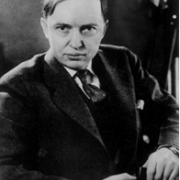- 1610: Galileo
- 1676: Ole Rømer
- 1687: Isaac Newton
- 1781: William Herschel
- 1838: Friedrich Bessel
- 1861: William and Margaret Huggins
- 1912: Henrietta Leavitt
- 1917 Einstein
- 1920: Harlow Shapley
- 1929 Edwin Hubble
- 1948: Ralph Alpher
- 1949: Fred Hoyle
- 1963: Maarten Schmidt
- 1964: Arno Penzias and Robert Wilson
- 1978: Vera Rubin and Kent Ford
- 1989: Margaret Geller and John Huchra
- 1992: John Mather and George Smoot
- 1995: Robert Williams
- 1998: Saul Perlmutter and Brian Schmidt
- 2010: Wendy Freedman
1920: Harlow Shapley Finds Our Place in the Milky Way
 |
| Portrait of Harlow Shapley. Image courtesy of Harvard College Observatory |
When Harlow Shapley began to study large groups of stars called globular clusters in 1914, very little was known about the overall shape of our galaxy or our place in it. By the time he finished his research in 1919, after publishing more than 40 research papers, the overall shape of our galaxy was coming into focus, including the position of our own solar system. Shapley’s discovery of our place in the galaxy was a remarkable achievement, comparable to discovering that the Earth orbits the Sun.
Shapley’s discoveries were made possible by what was then the largest telescope in the world, the 60-inch reflecting telescope at Mount Wilson Observatory in California, constructed through the efforts of the visionary astronomer George Ellery Hale. The Mount Wilson Observatory was funded by the Andrew Carnegie and Hale was the first director of the Observatories of the Carnegie Institution of Washington. Hale would later go on to build a 100-inch telescope at Mount Wilson, and the mammoth 200-inch telescope on Palomar Mountain.
Armed with the world’s most powerful telescope Shapley was able to identify Cephied variable stars in some of the nearest globular clusters, and he was able to use the luminosity-period relationship of Cepheids discovered by Henrietta Swan Leavitt a few years before to determine their relative distances. However, in order to determine absolute distances he first needed to determine the actual distance to at least one Cepheid. He and other astronomers worked together to accomplished that in 1915 using parallax and other methods.
Shapley used the Cepheid luminosity-period relationship to measure the distances to nearby globular clusters. He used other methods to measure more distant clusters that had no visible Cepheids. One method was to assume that all of the brightest stars must be about the same actual luminosity. He could then find the relative distance of the two galaxies from the inverse square law. For the most distant globular clusters, he measured the brightness of the entire cluster, and assumed that all globular clusters were about the intrinsic luminosity. His final estimates were not far from the modern values.
When he plotted the location of these clusters, an overall picture of the Milky Way galaxy emerged. The Sun, as it turned out, was located in the galactic disk, about two–thirds of the way out from the galactic center.
Shapley was also one of the most important contributors to solving the puzzle of the odd cloud-like objects collectively referred to as nebulae. Since William Herschel catalogued more than 2,500 of the objects, the construction of bigger and better telescopes revealed many more of them with a rich diversity of shapes and structures, including globular clusters. But there was a controversy about the locations of these objects. Shapley and other astronomers believed that all of these objects were contained within the Milky Way, and that in fact there was just one galaxy in the universe—ours. The other camp, lead by Heber Curtis, believed that at least some of the nebulae were in fact whole galaxies at vast distances.
Controversy is vital to the advancement of science because it helps focus attention on important questions and spurs individual scientists to gather new and better evidence, leading to greater insights. Such was the case of the nebulae. Curtis and Shapley met in April, 1920 to settle the question. Both astronomers distinguished themselves quite well in the debate, but scientific debates are not won on the basis good logic. The question would need to simmer for a few more years, until Edmund Hubble’s discovery of Cepheid variables in the Andromeda galaxy. Meanwhile Shapley was appointed Director of Harvard College Observatory, one of the most prestigious posts for an astronomer in the nation.